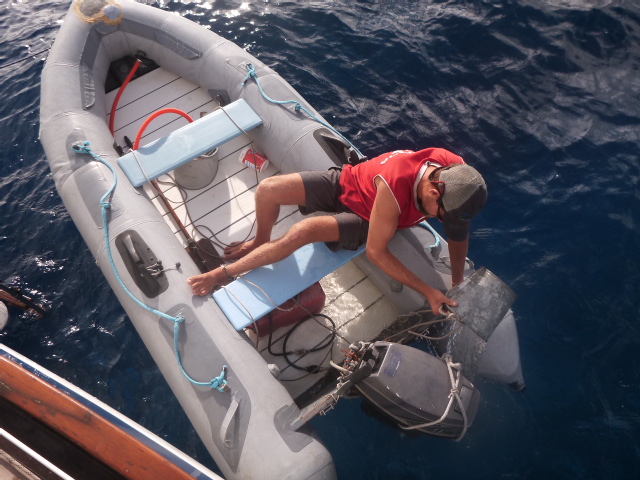El Coche: Our Dinghy/Kiddie Pool
It’s always an adventure in El Coche, the nickname Rob dubbed upon Compass Rose(y)’s 10-foot inflatable sidekick. We rely on El Coche for getting to shore to buy supplies like food and fuel, visiting neighbors, and exploring reefs. Basically, the dinghy is like your car at home: not essential to basic survival, but integral for your general sanity and daily well-being. El Coche gives us freedom. She gives us autonomy. She provides a much-needed escape from a very small vessel in a very big sea.
So its a real bummer that she leaks like a sieve and deflates like a burst balloon.
I try to tell myself that we’re lucky: not only do we have a dinghy, we also have a swimming pool to splash around in! That’s the rose-colored optimist view. Most days, I take the realist view: we have a dingy that loves water more than air. Occasionally, the pessimist comes out: this dinghy is sinking, and I’m f&%$ing sick of pumping and bailing.
It wasn’t always this bad. But it wasn’t ever good, either. Before Rob and I started as crew on Compass Rose(y), we would watch Mark and the owner motoring through anchorages, one of them constantly pumping up the nose. When we later agreed to crew, Rob told me determinedly: “I’m gonna try and patch that dinghy first thing.” And try he did. Again, and again. And again. And one last time.
The rubber on the bow won’t hold the patches. The patches on the floor don’t keep the ocean from pouring in. Every time he fixed one hole, a new gash appeared somewhere else. So, we’ve given in. We’re allowing El Coche a graceful and slow demise. It’s kind of like signing a “Do Not Resuscitate” order from your 98-year-old grandmother — she lived a good, long life, and it’s time for her to pass on peacefully.
Meanwhile, we have a half swimming pool/half boat, and provide plenty of comic relief for our fellow cruisers. El Coche is usually the butt of many jokes when she’s tied up at the dock. Hell, she’s the main source of our own daily amusement, since the best cure from pessimism is to joke while pumping and bailing.
Several people watch our labors with the pump nostalgically (did I mention the foot pump has broken twice, and you have to cover a whole with one hand while you pump with the other?). They say, wistfully, “Oh, that reminds me of our old dinghy.” And then they watch us bucket out 30 gallons of water from the bottom and revise their statement, “Wow, ours was never that bad.” If they actually brave a ride in El Coche, they marvel at her squishy-ness, and exclaim at the novelty of riding in a wet taco as the nose folds in. If the motor manages to plane the boat and unroll the taco, the floor becomes a swimming pool where random snorkels, shoes, ropes, groceries, and other random flotsam bang into toes and ankles.
At least the motor works … after 12-16 pulls on the starter cord. Usually. Except for that one time Rob and I were coming back from a snorkeling expedition in Tahaa across a 3-mile-wide channel with 25 knots of wind in our face. First it cut out because the gas tube was cracked. Rob patched it with his dive knife and his teeth, as the wind pushed us toward the reef and away from our sailboat. Then in the middle of the channel, the outboard died again and wouldn’t restart, even after 86 cranks of the starter cord.
That was the first time I’ve seen Rob lose his cool. He threw up his hands, yelled some swear words, and then said, “That’s it! We’re done for. We’re drifting toward Bora Bora, and there’s no way we can get back to the boat. This is EXACTLY why I would never have a boat without oars!”
I replied (cautiously), “Well, maybe we can at least use something as a rudder to steer toward the reef as we drift? Or use something to paddle…” This elicited an incredulous, “With what, Bri?!? Our hands? Oh, wait…” Rob ripped off the two blue plank seats, handed me one, and said, “Paddle HARD.”
Paddling with a heavy fiberglass plank is not ideal. But given the alternative, I followed orders. We paddled HARD for about 45 minutes until we made it to the other side of the channel, where we tied up on a reef to wait for the motor to recover from overheating. We managed to get back to Compass Rose(y) unscathed but really tired. The next day, Rob made a paddle out of a broom handle and piece of plywood he scavenged from a trash heap on shore.
We never leave the sailboat in El Coche without the paddle. Or without the bucket, the pump, the seats (emergency oars), and a handheld radio. A dry bag is a must, and we often pack an extra set of clothes inside it so we don’t have to sit through a dinner party as a salty wet mess. In fact, the prep checklist for our dinghy excursions is almost as long as our checklist for passage-making.
Ah, the joys of cruising. All told, El Coche still works to get us from Point A to Point B. Sure, you can see the turquoise water through the floor, but some people pay a lot of money for see-through boats. And my arms are nicely toned from the pump-and-bail routine. One thing is certain: even when I’m the most pessimistic about El Coche’s suckiness, I still know deep down that the freedom she provides is priceless and worth every ounce of frustration.






